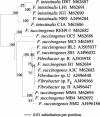Fiber-degrading systems of different strains of the genus Fibrobacter
- PMID: 15066810
- PMCID: PMC383150
- DOI: 10.1128/AEM.70.4.2172-2179.2004
Fiber-degrading systems of different strains of the genus Fibrobacter
Abstract
The S85 type strain of Fibrobacter succinogenes, a major ruminal fibrolytic species, was isolated 49 years ago from a bovine rumen and has been used since then as a model for extensive studies. To assess the validity of this model, we compared the cellulase- and xylanase-degrading activities of several other F. succinogenes strains originating from different ruminants, including recently isolated strains, and looked for the presence of 10 glycoside hydrolase genes previously identified in S85. The NR9 F. intestinalis type strain, representative of the second species of the genus, was also included in this study. DNA-DNA hybridization and 16S rRNA gene sequencing first classified the strains and provided the phylogenetic positions of isolates of both species. Cellulase and xylanase activity analyses revealed similar activity profiles for all F. succinogenes strains. However, the F(E) strain, phylogenetically close to S85, presented a poor xylanolytic system and weak specific activities. Furthermore, the HM2 strain, genetically distant from the other F. succinogenes isolates, displayed a larger cellulolytic profile on zymograms and higher cellulolytic specific activity. F. intestinalis NR9 presented a higher cellulolytic specific activity and a stronger extracellular xylanolytic activity. Almost all glycoside hydrolase genes studied were found in the F. succinogenes isolates by PCR, except in the HM2 strain, and few of them were detected in F. intestinalis NR9. As expected, the fibrolytic genes of strains of the genus Fibrobacter as well as the cellulase and xylanase activities are better conserved in closely related phylogenetic isolates.
Figures



References
-
- Amann, R. I., C. Lin, R. Key, L. Montgomery, and D. A. Stahl. 1992. Diversity among Fibrobacter isolates: towards a phylogenetic classification. Syst. Appl. Microbiol. 15:23-31.
-
- Begbie, R., and C. S. Stewart. 1984. Polyacrylamide gel electrophoresis of Bacteroides succinogenes. Can. J. Microbiol. 30:863-866. - PubMed
-
- Béra-Maillet, C., V. Broussolle, P. Pristas, J.-P. Girardeau, G. Gaudet, and E. Forano. 2000. Characterisation of endoglucanases EGB and EGC from Fibrobacter succinogenes. Biochim. Biophys. Acta 1476:191-202. - PubMed
-
- Béra-Maillet, C., G. Gaudet, and E. Forano. 2000. Endoglucanase activity and relative expression of glycosyl-hydrolase genes of Fibrobacter succinogenes S85 grown on different substrates. Biochim. Biophys. Acta 1543:77-85. - PubMed
-
- Bradford, M. M. 1976. A rapid sensitive method for the quantification of microgram quantities of protein, utilizing the principle of protein-dye binding. Anal. Biochem. 72:248-254. - PubMed
MeSH terms
Substances
Associated data
- Actions
- Actions
- Actions
- Actions
- Actions
- Actions
- Actions
- Actions
- Actions
- Actions
- Actions
LinkOut - more resources
Full Text Sources
Other Literature Sources
Molecular Biology Databases
Research Materials

